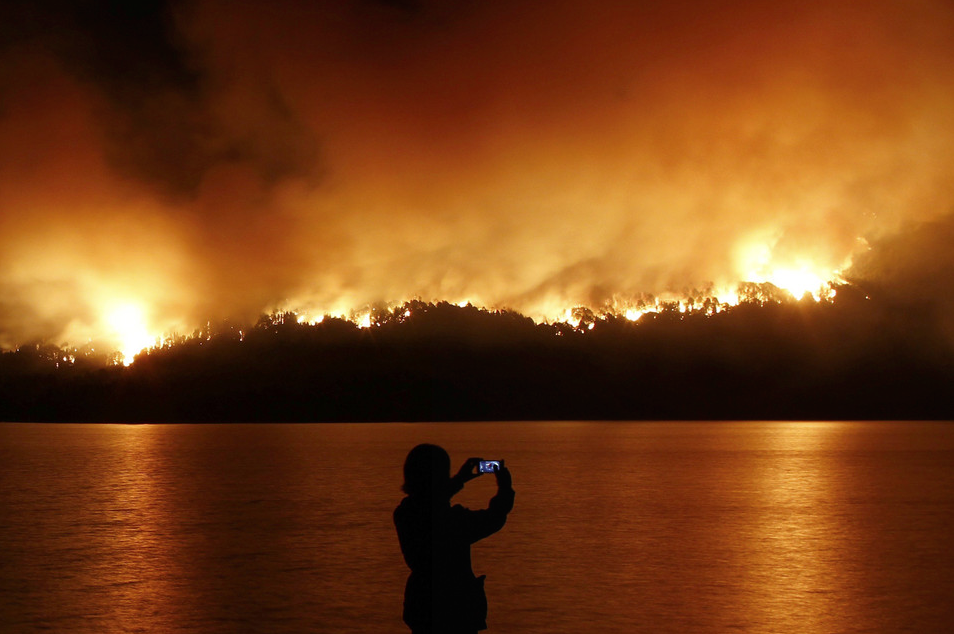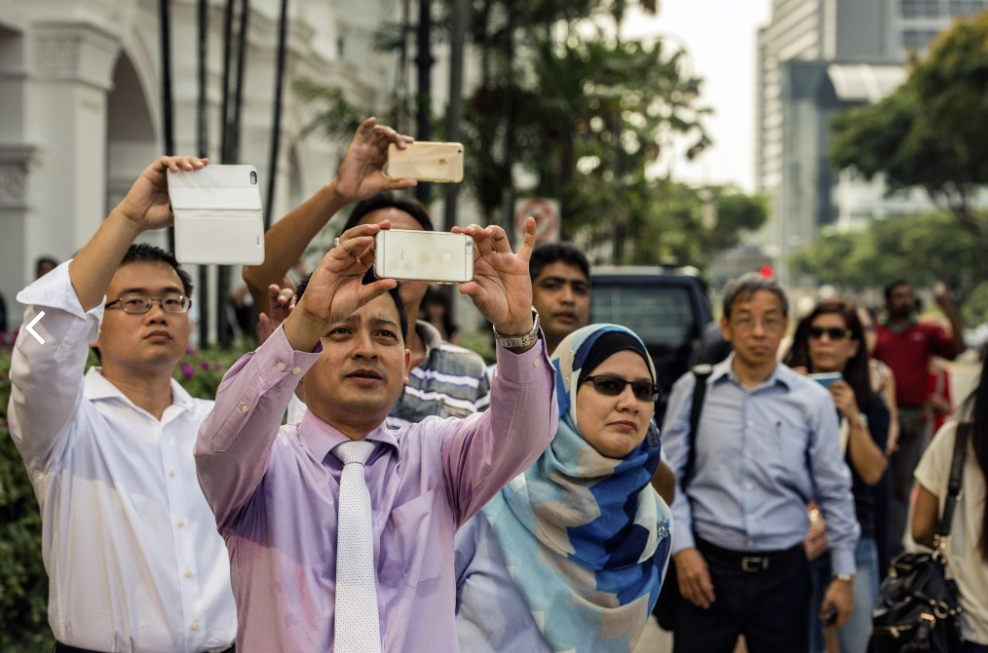The scene borders on the sublime. A silhouette of a woman cast in the glow of a distant fire that appears to be burning out of control. The gulf between the woman and the blaze is altogether calm, inviting a clear contrast with the raging flames and by extension underscoring the space—simultaneously near and far—between safety and danger. And, of course, it is the silhouette that ultimately frames the photograph and its affect. To get the point, imagine the photograph without the silhouette? The contrast of golden hues would still register as beautiful for most viewers no doubt, but all measure of the distance between here and there, of the sublime horror invoked by the image, would be effaced – or at least largely so.
All that aside, it was not color or even the silhouette that initially drew my attention to this photograph, but rather the fact that it is a photograph of someone taking a photograph. Photographs of people taking photographs has become something of a convention in recent times, and all the more so now that many (if not most) people in the western world carry cameras with them in their pockets and seem inclined to take photographs of … well, just about everything. And the question is, why? Not why do people take photographs of everything. I think we have done that for a long time now, contemporary technologies simply making it easier and easier to do. Rather, the question is, why has the photograph of people taking photographs become something of a visual trope … and a trope of what? In the photograph above the camera’s brightly lit screen stands in stark contrast with the golden color cast of just about everything else in the image—including the silhouetted photographer—and thus perhaps invokes a sense of the tension between nature and technology, a point gestured to by the caption which notes: “A woman takes a picture of fires raging through the Los Alerces National Park … A lighting strike is believed to be the cause.” And so the photograph here might indeed be driven by a profoundly artistic and/or ideological sentimentality. There is of course no way to know, but the omnipresence of the technology in modern times simply cannot be ignored.
The trope is perhaps a bit harder to explain in other, more common occurrences such as this photograph:
Here the caption reads: “People take photographs as the body of Lee Kuan Yew, Singapore’s first Prime Minister is transferred form the Instana Presidential Palace.” One might wonder why we don’t just have a photograph of the body itself being transferred. Or, for that matter, of the crowds gathered to view the transference. What is it about the fact that people are taking photographs of this scene that makes the convention so affecting?
I don’t have an answer to this question firmly worked out at the moment, but my suspicion is that it has something to do with the relationship between actors and spectators. There was a time, not so very long ago, when the prevailing assumption was that citizen spectators lacked agency. They viewed events, but they did it from an altogether passive space that muted their political voice if it did not erase it altogether. The seeing citizen did little more than see. The advance of camera technologies, and in particular the utter ubiquity of camera phones and portable screens, as well as the capacity for digital circulation, has given citizen spectators a whole new way of registering their voice—or is it their gaze? It helps us to see how one person uses their spectatorship to accent the space between culture and nature, as in the silhouette above, or how others mark the importance of the passing of a revered leader. In short, the seeing citizen is now also, and at least in some measure, an acting citizen.
We photograph people taking photographs perhaps because it marks an important shift in what it means to be a citizen spectator and, as with photojournalistic images in general, it helps us to understand how we see and are seen as citizens.
Photo Credit: Emiliano LaSalvia/Agence France-Presse/Getty Images; Tom White/European Pressphoto Agency.
Cross-posted at BagNewsNotes.


Photographers at work in Havana-
http://www.efn.org/~hkrieger/cu0311.jpg
http://www.efn.org/~hkrieger/cu1212.jpg
Hi John. I took the photo of the spectators photographing the procession transferring the body of Singapore’s late first Prime Minister Lee Kuan Yew. Thanks for including the picture here. I would just like to share a short anecdote.
On the day of the actual funeral the body was once again paraded through the streets. On it’s final journey from the ceremony to the crematorium it had just passed where I was standing. I had finished photographing and was walking along the road to find a spot to sit and file pictures when I passed an elderly couple walking in the opposite direction looking down at their phones. Neither had as up to date or fancy a phone as the one’s held in the photo reproduced here – they were both older, less sophisticated phones.
As I passed I glanced down at what they were looking at on their screens. The elderly gentleman had a photo on his phone, obviously one he had just taken of the casket passing by. The photo was blurred and low resolution. There were many many photographs taken of the event. If you want an image of the casket passing there is no shortage of options. But this low res blurred photo was his photo. An affirmation of what he witnessed. In many ways a photograph is a way of saying I was there, this is what I saw. We have always used photography in this way.
What I find interesting is whether the widespread use of the pervasive technology will contribute to an increase in visual literacy or if it will just be a tool to simple state that all important affirmation of our own existence. This is what I witnessed. This is what I participated in. I was there.
Interestingly enough, there was a campaign started by members of the public to ask people to not photograph the funeral procession. People were asked to ‘show your appreciation not your phones’. To not photograph as a mark of respect is something that in our increasingly imaged world is becoming something I have come across more than once.
http://www.straitstimes.com/news/singapore/more-singapore-stories/story/request-public-keep-phones-away-salute-mr-lee-kuan-yew-s
You can also see more of my coverage of the passing of Lee Kuan Yew here:
http://www.epa.eu/webgate?SERIESDISPLAY=1&EVENT=WEBSHOP_SEARCH&SEARCHLANGUAGE=eng_usa&SEARCHMODE=NEW&SEARCHTXT1=Tom+White+Lee+Kuan+Yew
Tom: Fascinating. Thanks for reading and writing in — and, of course, for photographing!
A quick word on the photograph itself: I had just finished photographing the Funeral Procession and as is my custom turned around to see what was going on around me – I was struck not only by the fact that these people were also photographing the procession, but also the business attire and the champagne gold of the phones themselves. I have been photographing the displays of wealth since I arrived in Singapore – a country with a high percentage of wealthy individuals and a large income gap between rich and poor – so initially it was not just the act of photographing that I was interested in representing, but the trappings of an expensive lifestyle, in the context of the social leveller of a public event. the universal functionality of a device that can also be a status symbol.
Tom: Once again, thanks. A reminder that an image can tell many different stories and we need to develop the literacy to recognize the range of possibilities in any given one.
“I have been photographing the displays of wealth since I arrived in Singapore – a country with a high percentage of wealthy individuals and a large income gap between rich and poor…”.
A gap represented in the difference between these phones and the “older, less sophisticated phones” you mention in your first comment, Tom. Would be interesting to juxtapose images of the people from those respective worlds doing the same thing with quite different equipment and (I assume) attire.
—wayne
photo
Wayne, yes indeed, the juxtaposition would be interesting…. Perhaps you might find this photograph taken by Joe Nair working for the Associated Press from the same day. https://sg.news.yahoo.com/photos/late-lee-kuan-yew-s-body-lying-in-state-at-parliament-house-slideshow/members-public-pictures-shout-thank-mr-lee-coffin-photo-021132315.html